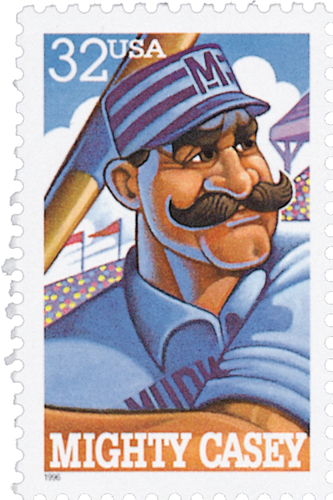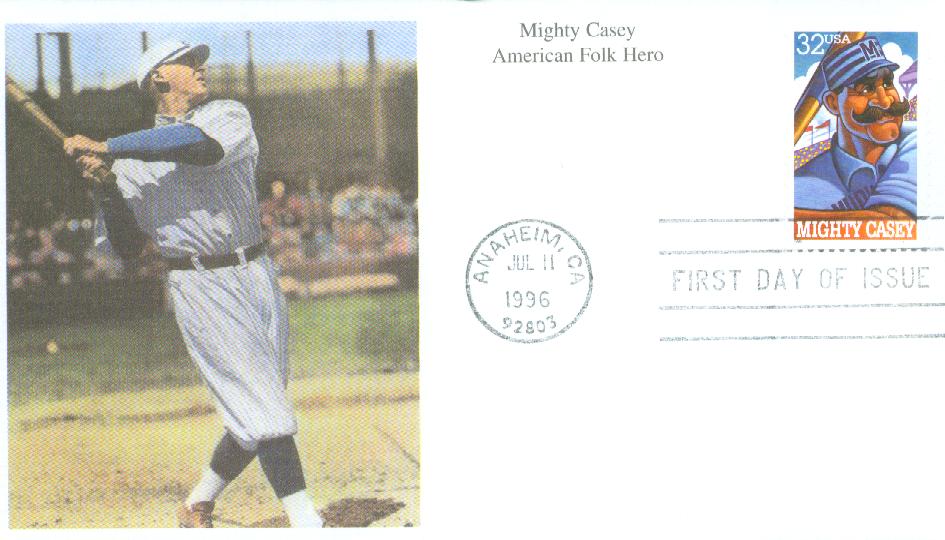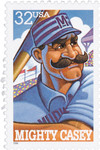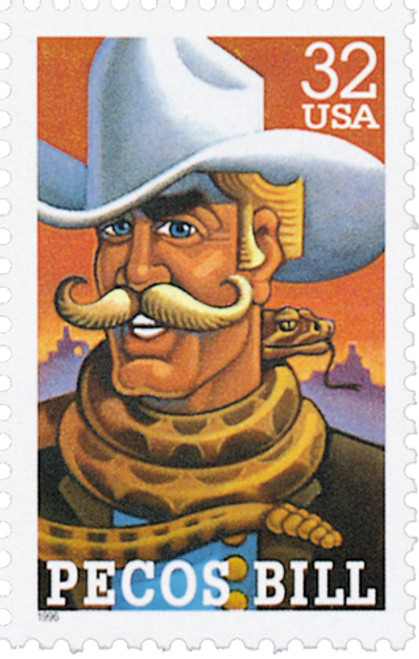
# 3083 - 1996 32c Folk Heroes: Mighty Casey
US #3083
1996 Mighty Casey
- Part of set of four featuring characters from American Folklore
Stamp Category: Commemorative
Set: Folk Heroes
Value: 32¢, First-class mail rate
First Day of Issue: July 11, 1996
First Day City: Anaheim, California
Quantity Issued: 23,687,500
Printed by: Ashton-Potter (USA) Ltd.
Printing Method: Lithographed
Format: Panes of 20 (5 across, 4 down) from plates of 120 subjects (8 across, 15 down)
Perforations: 11.1
Why the stamp was issued: The set of four Folk Heroes stamps were issued to celebrate folklore characters of America.
About the stamp design: The stamp artwork was made by Dave LaFleur, a commercial illustrator. His style is similar to murals and posters created during the New Deal era in America and Soviet propaganda art. LeFleur’s characters show strength through their thick necks and strong jaws. For his portraits, LaFleur didn’t want to be influenced by anyone else’s illustrations, so he read their stories in books without illustrations to develop his own images of the men. He painted the Folk Heroes using oil paints rather than acrylics or watercolors used for most stamp art.
Initially, the USPS had tasked Dave LaFleur with painting six folk heroes “ the four that were issued as well as Johnny Appleseed and Rip Van Winkle. They liked his paintings but decided to make it a set of four. Pecos Bill, Paul Bunyan, John Henry, and Mighty Casey were chosen to be portrayed.
First Day City: The Folk Heroes stamps were issued on the opening day of the American Stamp Dealers Association’s Postage Stamp Mega-Event, held in Anaheim, California. Actors portraying the four characters featured on the stamps were in attendance at the ceremony.
Unusual fact about these stamps: The Folk Heroes stamps weren’t the first to feature characters from American folklore. In 1966, the US Post Office Department began issuing stamps in the American Folklore series. These highlighted Johnny Appleseed, Davy Crockett, Daniel Boone, Grandma Moses, and Tom Sawyer, as well as Ichabod Crane and the Headless Horseman.
About the Folk Heroes stamps:
This set of four commemorates some of the greatest heroes of American folklore. These four men were known for their super human strength and size, with a personality to match.
"Casey At The Bat"

On June 3, 1888, the now-famous poem "Casey at the Bat" was first published in the San Francisco Daily Examiner.
Ernest Lawrence Thayer wrote "Casey at the Bat." Born in Lawrence, Massachusetts in 1863, Thayer earned a degree in philosophy from Harvard University before accepting a job offer from his friend, William Randolph Hearst, to work as the humor columnist for the Daily Examiner in 1886.
Over the next two years Thayer wrote for a variety of the paper's sections, including advertisements and editorials. But it would be his last piece for the paper that would make him famous. He published "Casey at the Bat" on June 3, 1888, under the pseudonym "Phin" as he had all his other works for the paper.
The poem went relatively unnoticed for a couple months until actor De Wolf Hopper staged the first public performance that August. It soon became the most famous baseball poem ever and Hopper would go on to recite the poem 10,000 (some sources say up to 40,000) times during his lifetime.

Over the years, there's been lots of speculation over who and where may have served as inspiration for the poem. Two towns have claimed to be the models for Mudville: Stockton, California, and Holliston, Massachusetts.
And while Thayer insisted Casey wasn't based on a single player, many believe he was at least in part inspired by Mike "King" Kelly. Thayer had worked as a baseball reporter for Kelly's team's exhibition games between the 1887 to 1888 off-season. Some of his language referring to Kelly's at-bats was even similar to how he wrote about Casey.
"Casey at the Bat" was eventually made into a silent film in 1927 and a Disney animated short in 1946.
Click here to read the full text of the poem.
US #3083
1996 Mighty Casey
- Part of set of four featuring characters from American Folklore
Stamp Category: Commemorative
Set: Folk Heroes
Value: 32¢, First-class mail rate
First Day of Issue: July 11, 1996
First Day City: Anaheim, California
Quantity Issued: 23,687,500
Printed by: Ashton-Potter (USA) Ltd.
Printing Method: Lithographed
Format: Panes of 20 (5 across, 4 down) from plates of 120 subjects (8 across, 15 down)
Perforations: 11.1
Why the stamp was issued: The set of four Folk Heroes stamps were issued to celebrate folklore characters of America.
About the stamp design: The stamp artwork was made by Dave LaFleur, a commercial illustrator. His style is similar to murals and posters created during the New Deal era in America and Soviet propaganda art. LeFleur’s characters show strength through their thick necks and strong jaws. For his portraits, LaFleur didn’t want to be influenced by anyone else’s illustrations, so he read their stories in books without illustrations to develop his own images of the men. He painted the Folk Heroes using oil paints rather than acrylics or watercolors used for most stamp art.
Initially, the USPS had tasked Dave LaFleur with painting six folk heroes “ the four that were issued as well as Johnny Appleseed and Rip Van Winkle. They liked his paintings but decided to make it a set of four. Pecos Bill, Paul Bunyan, John Henry, and Mighty Casey were chosen to be portrayed.
First Day City: The Folk Heroes stamps were issued on the opening day of the American Stamp Dealers Association’s Postage Stamp Mega-Event, held in Anaheim, California. Actors portraying the four characters featured on the stamps were in attendance at the ceremony.
Unusual fact about these stamps: The Folk Heroes stamps weren’t the first to feature characters from American folklore. In 1966, the US Post Office Department began issuing stamps in the American Folklore series. These highlighted Johnny Appleseed, Davy Crockett, Daniel Boone, Grandma Moses, and Tom Sawyer, as well as Ichabod Crane and the Headless Horseman.
About the Folk Heroes stamps:
This set of four commemorates some of the greatest heroes of American folklore. These four men were known for their super human strength and size, with a personality to match.
"Casey At The Bat"

On June 3, 1888, the now-famous poem "Casey at the Bat" was first published in the San Francisco Daily Examiner.
Ernest Lawrence Thayer wrote "Casey at the Bat." Born in Lawrence, Massachusetts in 1863, Thayer earned a degree in philosophy from Harvard University before accepting a job offer from his friend, William Randolph Hearst, to work as the humor columnist for the Daily Examiner in 1886.
Over the next two years Thayer wrote for a variety of the paper's sections, including advertisements and editorials. But it would be his last piece for the paper that would make him famous. He published "Casey at the Bat" on June 3, 1888, under the pseudonym "Phin" as he had all his other works for the paper.
The poem went relatively unnoticed for a couple months until actor De Wolf Hopper staged the first public performance that August. It soon became the most famous baseball poem ever and Hopper would go on to recite the poem 10,000 (some sources say up to 40,000) times during his lifetime.

Over the years, there's been lots of speculation over who and where may have served as inspiration for the poem. Two towns have claimed to be the models for Mudville: Stockton, California, and Holliston, Massachusetts.
And while Thayer insisted Casey wasn't based on a single player, many believe he was at least in part inspired by Mike "King" Kelly. Thayer had worked as a baseball reporter for Kelly's team's exhibition games between the 1887 to 1888 off-season. Some of his language referring to Kelly's at-bats was even similar to how he wrote about Casey.
"Casey at the Bat" was eventually made into a silent film in 1927 and a Disney animated short in 1946.
Click here to read the full text of the poem.











